Human Resource Management: Employee Wellbeing Analysis Essay
VerifiedAdded on 2022/08/16
|12
|4144
|16
Essay
AI Summary
This essay delves into the concept of employee wellbeing, emphasizing its significance beyond physical and mental health to encompass overall employee optimization, job satisfaction, and happiness. It explores the scope, importance, and limitations of employee wellbeing within human resource management (HRM). The essay highlights how employee wellbeing initiatives improve employee behavior, reduce health risks, and boost organizational productivity. The essay discusses the impact of employee wellbeing on employee behavior, health, and the financial performance of the company. Furthermore, the essay provides two organizational examples: HSBC Holdings Plc, demonstrating how organizations can implement strategies that encompass social, financial, psychological, and physical wellbeing. These strategies include providing financial support, organizing fitness activities, counseling sessions and reward policies which increase employee engagement, satisfaction, and organizational performance. This leads to increased productivity, employee retention, and improved financial outcomes, ultimately benefiting both employees and the organization.
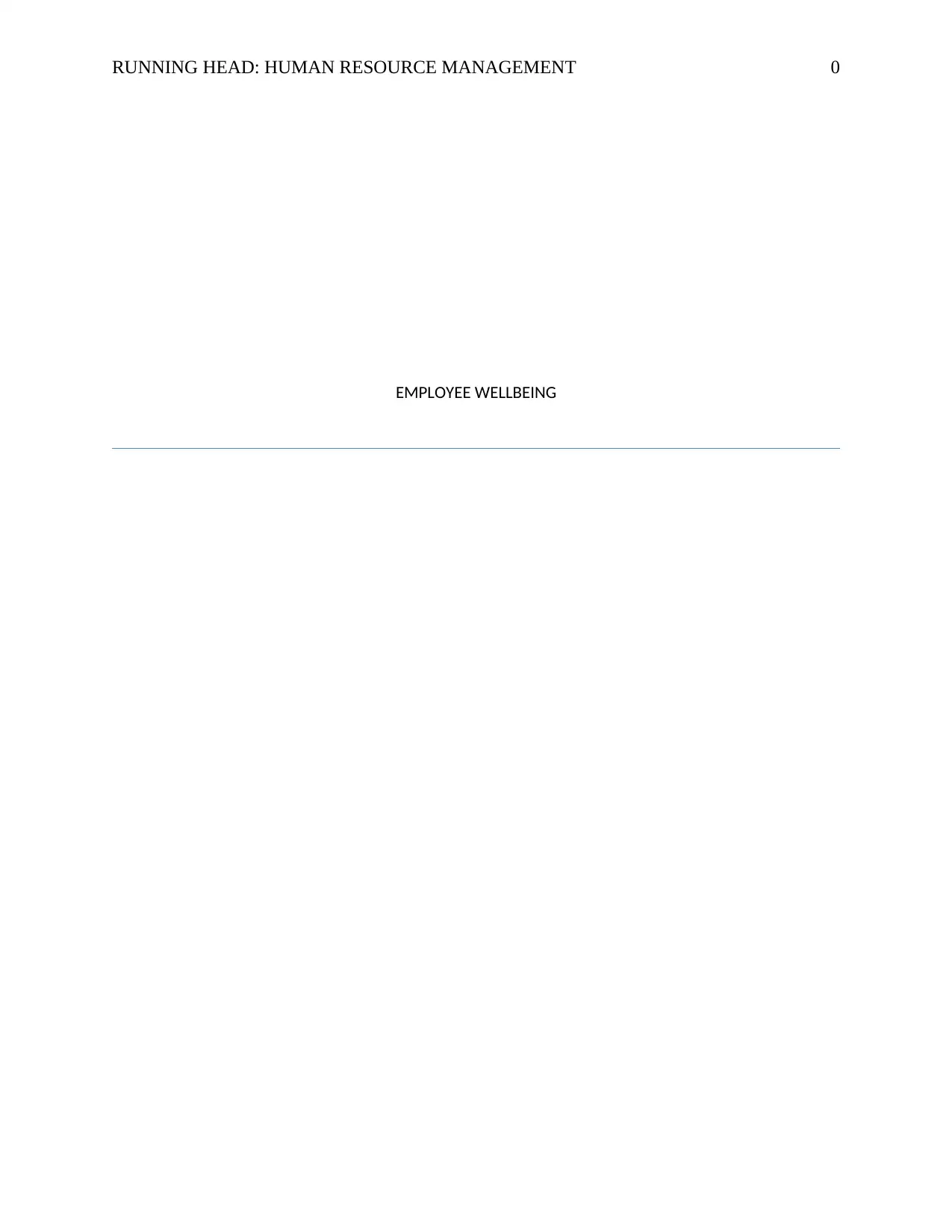
RUNNING HEAD: HUMAN RESOURCE MANAGEMENT 0
EMPLOYEE WELLBEING
EMPLOYEE WELLBEING
Paraphrase This Document
Need a fresh take? Get an instant paraphrase of this document with our AI Paraphraser
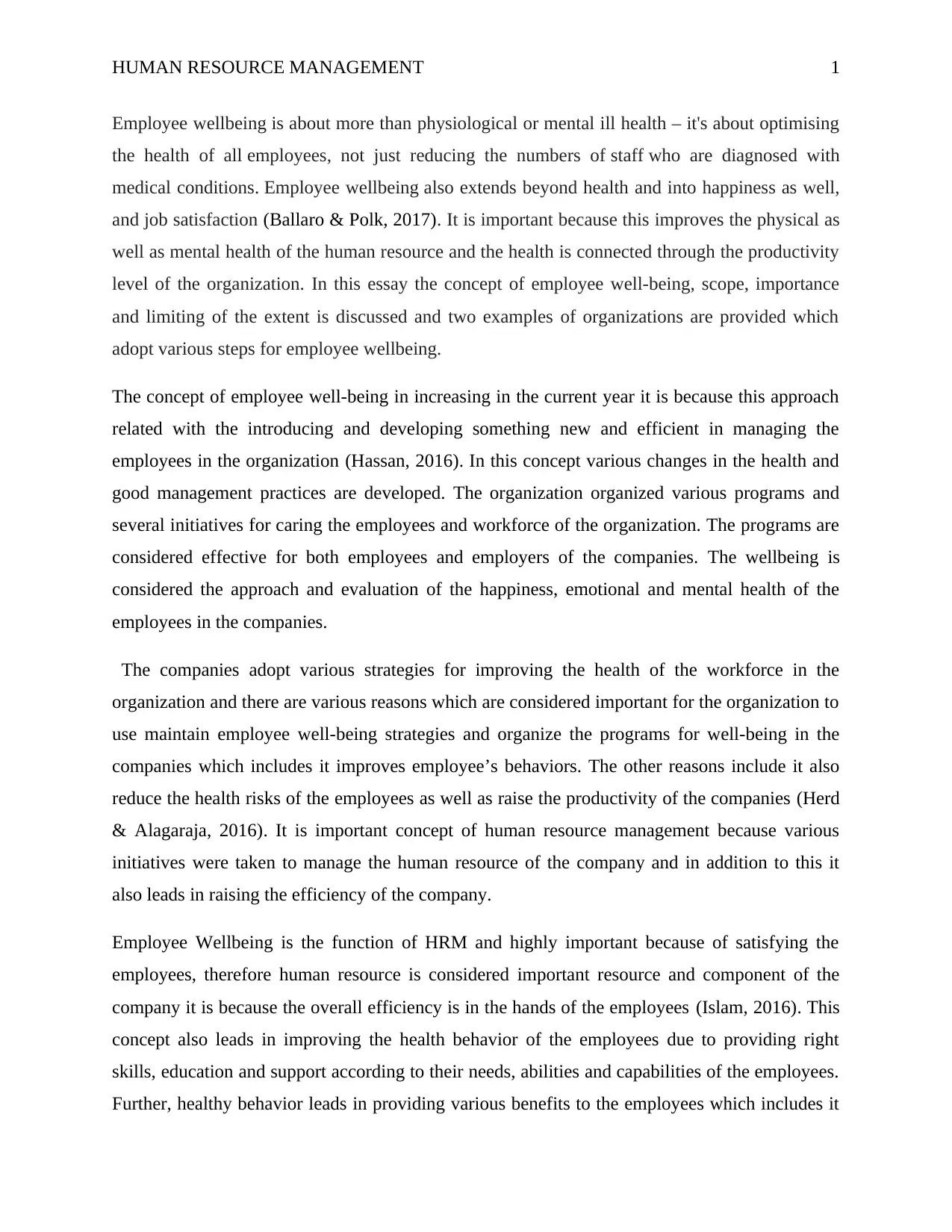
HUMAN RESOURCE MANAGEMENT 1
Employee wellbeing is about more than physiological or mental ill health – it's about optimising
the health of all employees, not just reducing the numbers of staff who are diagnosed with
medical conditions. Employee wellbeing also extends beyond health and into happiness as well,
and job satisfaction (Ballaro & Polk, 2017). It is important because this improves the physical as
well as mental health of the human resource and the health is connected through the productivity
level of the organization. In this essay the concept of employee well-being, scope, importance
and limiting of the extent is discussed and two examples of organizations are provided which
adopt various steps for employee wellbeing.
The concept of employee well-being in increasing in the current year it is because this approach
related with the introducing and developing something new and efficient in managing the
employees in the organization (Hassan, 2016). In this concept various changes in the health and
good management practices are developed. The organization organized various programs and
several initiatives for caring the employees and workforce of the organization. The programs are
considered effective for both employees and employers of the companies. The wellbeing is
considered the approach and evaluation of the happiness, emotional and mental health of the
employees in the companies.
The companies adopt various strategies for improving the health of the workforce in the
organization and there are various reasons which are considered important for the organization to
use maintain employee well-being strategies and organize the programs for well-being in the
companies which includes it improves employee’s behaviors. The other reasons include it also
reduce the health risks of the employees as well as raise the productivity of the companies (Herd
& Alagaraja, 2016). It is important concept of human resource management because various
initiatives were taken to manage the human resource of the company and in addition to this it
also leads in raising the efficiency of the company.
Employee Wellbeing is the function of HRM and highly important because of satisfying the
employees, therefore human resource is considered important resource and component of the
company it is because the overall efficiency is in the hands of the employees (Islam, 2016). This
concept also leads in improving the health behavior of the employees due to providing right
skills, education and support according to their needs, abilities and capabilities of the employees.
Further, healthy behavior leads in providing various benefits to the employees which includes it
Employee wellbeing is about more than physiological or mental ill health – it's about optimising
the health of all employees, not just reducing the numbers of staff who are diagnosed with
medical conditions. Employee wellbeing also extends beyond health and into happiness as well,
and job satisfaction (Ballaro & Polk, 2017). It is important because this improves the physical as
well as mental health of the human resource and the health is connected through the productivity
level of the organization. In this essay the concept of employee well-being, scope, importance
and limiting of the extent is discussed and two examples of organizations are provided which
adopt various steps for employee wellbeing.
The concept of employee well-being in increasing in the current year it is because this approach
related with the introducing and developing something new and efficient in managing the
employees in the organization (Hassan, 2016). In this concept various changes in the health and
good management practices are developed. The organization organized various programs and
several initiatives for caring the employees and workforce of the organization. The programs are
considered effective for both employees and employers of the companies. The wellbeing is
considered the approach and evaluation of the happiness, emotional and mental health of the
employees in the companies.
The companies adopt various strategies for improving the health of the workforce in the
organization and there are various reasons which are considered important for the organization to
use maintain employee well-being strategies and organize the programs for well-being in the
companies which includes it improves employee’s behaviors. The other reasons include it also
reduce the health risks of the employees as well as raise the productivity of the companies (Herd
& Alagaraja, 2016). It is important concept of human resource management because various
initiatives were taken to manage the human resource of the company and in addition to this it
also leads in raising the efficiency of the company.
Employee Wellbeing is the function of HRM and highly important because of satisfying the
employees, therefore human resource is considered important resource and component of the
company it is because the overall efficiency is in the hands of the employees (Islam, 2016). This
concept also leads in improving the health behavior of the employees due to providing right
skills, education and support according to their needs, abilities and capabilities of the employees.
Further, healthy behavior leads in providing various benefits to the employees which includes it
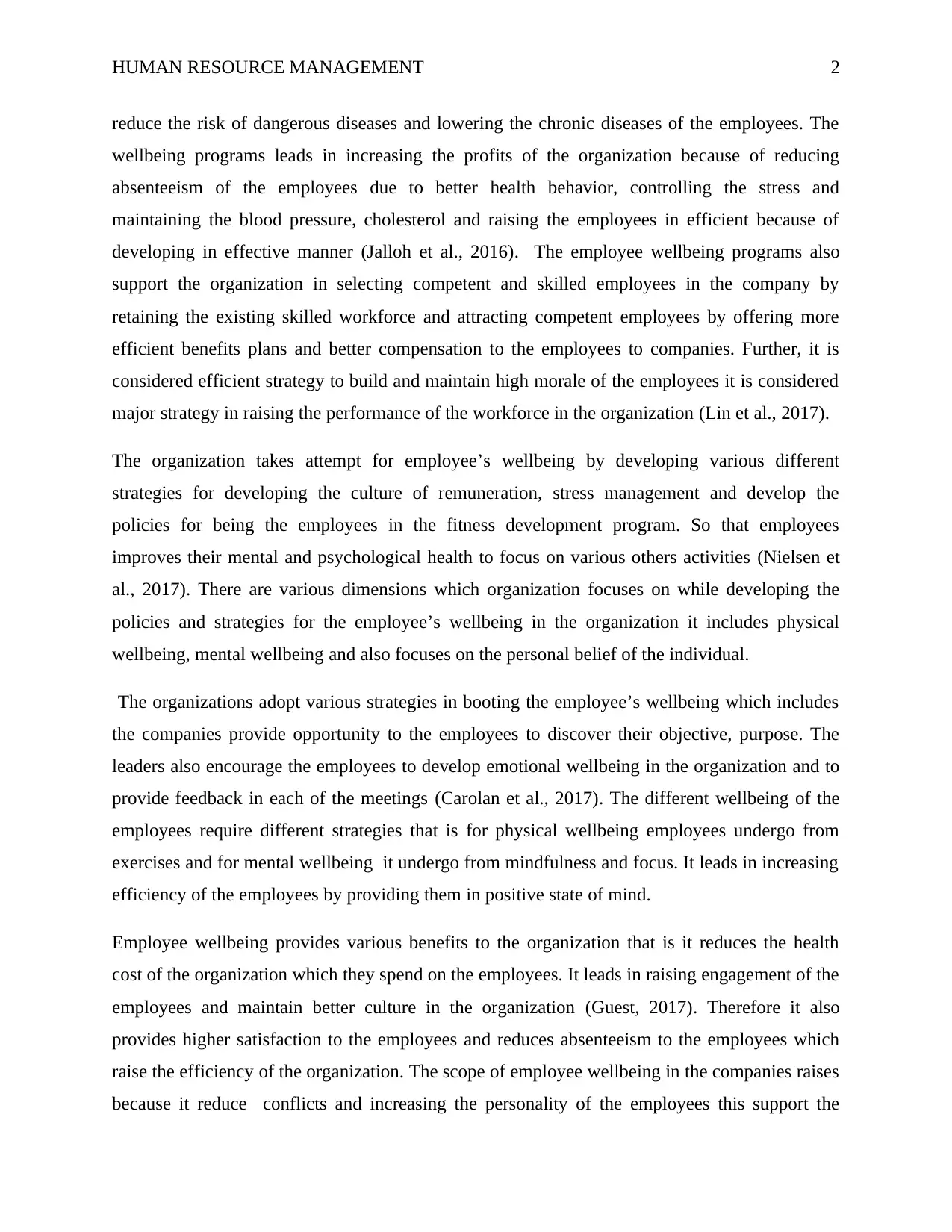
HUMAN RESOURCE MANAGEMENT 2
reduce the risk of dangerous diseases and lowering the chronic diseases of the employees. The
wellbeing programs leads in increasing the profits of the organization because of reducing
absenteeism of the employees due to better health behavior, controlling the stress and
maintaining the blood pressure, cholesterol and raising the employees in efficient because of
developing in effective manner (Jalloh et al., 2016). The employee wellbeing programs also
support the organization in selecting competent and skilled employees in the company by
retaining the existing skilled workforce and attracting competent employees by offering more
efficient benefits plans and better compensation to the employees to companies. Further, it is
considered efficient strategy to build and maintain high morale of the employees it is considered
major strategy in raising the performance of the workforce in the organization (Lin et al., 2017).
The organization takes attempt for employee’s wellbeing by developing various different
strategies for developing the culture of remuneration, stress management and develop the
policies for being the employees in the fitness development program. So that employees
improves their mental and psychological health to focus on various others activities (Nielsen et
al., 2017). There are various dimensions which organization focuses on while developing the
policies and strategies for the employee’s wellbeing in the organization it includes physical
wellbeing, mental wellbeing and also focuses on the personal belief of the individual.
The organizations adopt various strategies in booting the employee’s wellbeing which includes
the companies provide opportunity to the employees to discover their objective, purpose. The
leaders also encourage the employees to develop emotional wellbeing in the organization and to
provide feedback in each of the meetings (Carolan et al., 2017). The different wellbeing of the
employees require different strategies that is for physical wellbeing employees undergo from
exercises and for mental wellbeing it undergo from mindfulness and focus. It leads in increasing
efficiency of the employees by providing them in positive state of mind.
Employee wellbeing provides various benefits to the organization that is it reduces the health
cost of the organization which they spend on the employees. It leads in raising engagement of the
employees and maintain better culture in the organization (Guest, 2017). Therefore it also
provides higher satisfaction to the employees and reduces absenteeism to the employees which
raise the efficiency of the organization. The scope of employee wellbeing in the companies raises
because it reduce conflicts and increasing the personality of the employees this support the
reduce the risk of dangerous diseases and lowering the chronic diseases of the employees. The
wellbeing programs leads in increasing the profits of the organization because of reducing
absenteeism of the employees due to better health behavior, controlling the stress and
maintaining the blood pressure, cholesterol and raising the employees in efficient because of
developing in effective manner (Jalloh et al., 2016). The employee wellbeing programs also
support the organization in selecting competent and skilled employees in the company by
retaining the existing skilled workforce and attracting competent employees by offering more
efficient benefits plans and better compensation to the employees to companies. Further, it is
considered efficient strategy to build and maintain high morale of the employees it is considered
major strategy in raising the performance of the workforce in the organization (Lin et al., 2017).
The organization takes attempt for employee’s wellbeing by developing various different
strategies for developing the culture of remuneration, stress management and develop the
policies for being the employees in the fitness development program. So that employees
improves their mental and psychological health to focus on various others activities (Nielsen et
al., 2017). There are various dimensions which organization focuses on while developing the
policies and strategies for the employee’s wellbeing in the organization it includes physical
wellbeing, mental wellbeing and also focuses on the personal belief of the individual.
The organizations adopt various strategies in booting the employee’s wellbeing which includes
the companies provide opportunity to the employees to discover their objective, purpose. The
leaders also encourage the employees to develop emotional wellbeing in the organization and to
provide feedback in each of the meetings (Carolan et al., 2017). The different wellbeing of the
employees require different strategies that is for physical wellbeing employees undergo from
exercises and for mental wellbeing it undergo from mindfulness and focus. It leads in increasing
efficiency of the employees by providing them in positive state of mind.
Employee wellbeing provides various benefits to the organization that is it reduces the health
cost of the organization which they spend on the employees. It leads in raising engagement of the
employees and maintain better culture in the organization (Guest, 2017). Therefore it also
provides higher satisfaction to the employees and reduces absenteeism to the employees which
raise the efficiency of the organization. The scope of employee wellbeing in the companies raises
because it reduce conflicts and increasing the personality of the employees this support the
⊘ This is a preview!⊘
Do you want full access?
Subscribe today to unlock all pages.

Trusted by 1+ million students worldwide
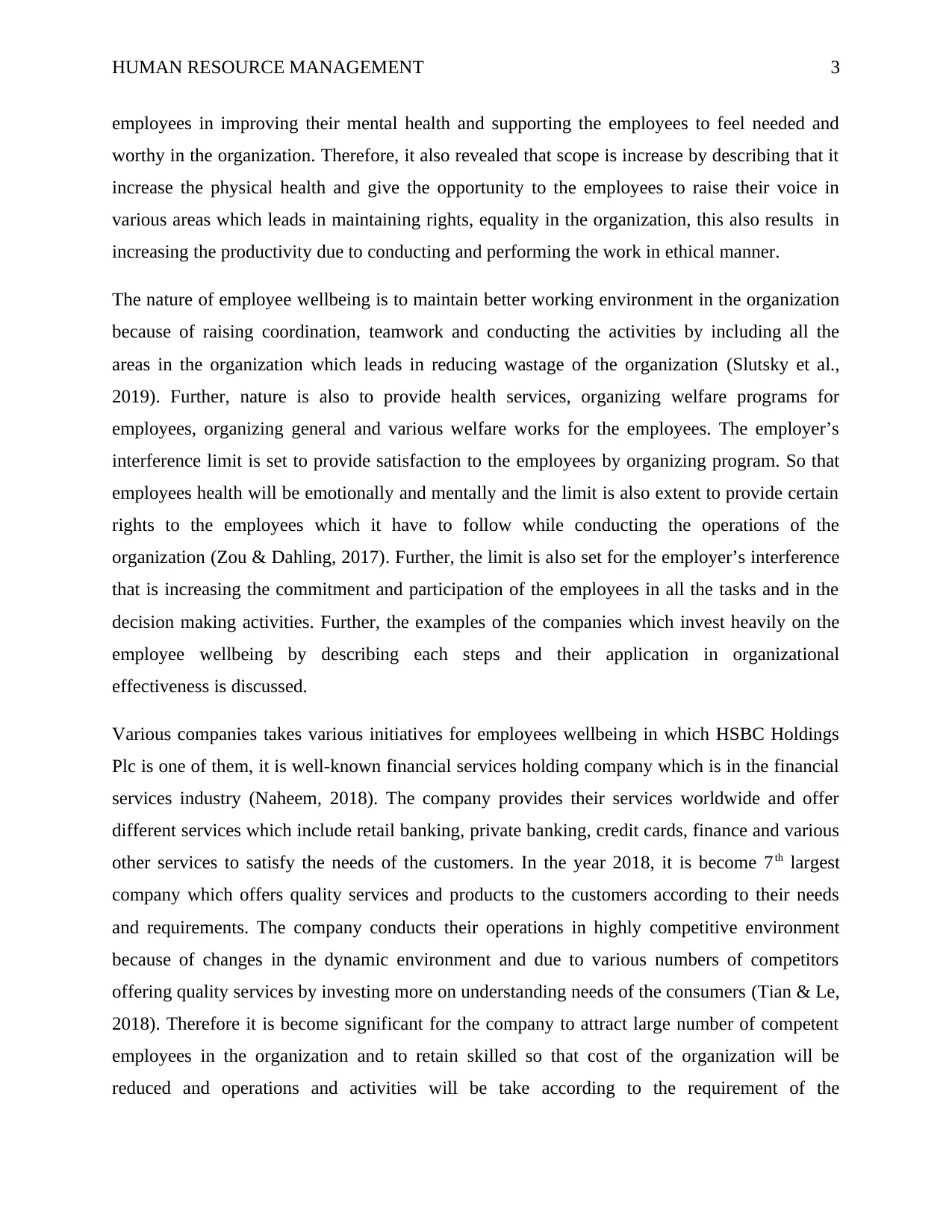
HUMAN RESOURCE MANAGEMENT 3
employees in improving their mental health and supporting the employees to feel needed and
worthy in the organization. Therefore, it also revealed that scope is increase by describing that it
increase the physical health and give the opportunity to the employees to raise their voice in
various areas which leads in maintaining rights, equality in the organization, this also results in
increasing the productivity due to conducting and performing the work in ethical manner.
The nature of employee wellbeing is to maintain better working environment in the organization
because of raising coordination, teamwork and conducting the activities by including all the
areas in the organization which leads in reducing wastage of the organization (Slutsky et al.,
2019). Further, nature is also to provide health services, organizing welfare programs for
employees, organizing general and various welfare works for the employees. The employer’s
interference limit is set to provide satisfaction to the employees by organizing program. So that
employees health will be emotionally and mentally and the limit is also extent to provide certain
rights to the employees which it have to follow while conducting the operations of the
organization (Zou & Dahling, 2017). Further, the limit is also set for the employer’s interference
that is increasing the commitment and participation of the employees in all the tasks and in the
decision making activities. Further, the examples of the companies which invest heavily on the
employee wellbeing by describing each steps and their application in organizational
effectiveness is discussed.
Various companies takes various initiatives for employees wellbeing in which HSBC Holdings
Plc is one of them, it is well-known financial services holding company which is in the financial
services industry (Naheem, 2018). The company provides their services worldwide and offer
different services which include retail banking, private banking, credit cards, finance and various
other services to satisfy the needs of the customers. In the year 2018, it is become 7th largest
company which offers quality services and products to the customers according to their needs
and requirements. The company conducts their operations in highly competitive environment
because of changes in the dynamic environment and due to various numbers of competitors
offering quality services by investing more on understanding needs of the consumers (Tian & Le,
2018). Therefore it is become significant for the company to attract large number of competent
employees in the organization and to retain skilled so that cost of the organization will be
reduced and operations and activities will be take according to the requirement of the
employees in improving their mental health and supporting the employees to feel needed and
worthy in the organization. Therefore, it also revealed that scope is increase by describing that it
increase the physical health and give the opportunity to the employees to raise their voice in
various areas which leads in maintaining rights, equality in the organization, this also results in
increasing the productivity due to conducting and performing the work in ethical manner.
The nature of employee wellbeing is to maintain better working environment in the organization
because of raising coordination, teamwork and conducting the activities by including all the
areas in the organization which leads in reducing wastage of the organization (Slutsky et al.,
2019). Further, nature is also to provide health services, organizing welfare programs for
employees, organizing general and various welfare works for the employees. The employer’s
interference limit is set to provide satisfaction to the employees by organizing program. So that
employees health will be emotionally and mentally and the limit is also extent to provide certain
rights to the employees which it have to follow while conducting the operations of the
organization (Zou & Dahling, 2017). Further, the limit is also set for the employer’s interference
that is increasing the commitment and participation of the employees in all the tasks and in the
decision making activities. Further, the examples of the companies which invest heavily on the
employee wellbeing by describing each steps and their application in organizational
effectiveness is discussed.
Various companies takes various initiatives for employees wellbeing in which HSBC Holdings
Plc is one of them, it is well-known financial services holding company which is in the financial
services industry (Naheem, 2018). The company provides their services worldwide and offer
different services which include retail banking, private banking, credit cards, finance and various
other services to satisfy the needs of the customers. In the year 2018, it is become 7th largest
company which offers quality services and products to the customers according to their needs
and requirements. The company conducts their operations in highly competitive environment
because of changes in the dynamic environment and due to various numbers of competitors
offering quality services by investing more on understanding needs of the consumers (Tian & Le,
2018). Therefore it is become significant for the company to attract large number of competent
employees in the organization and to retain skilled so that cost of the organization will be
reduced and operations and activities will be take according to the requirement of the
Paraphrase This Document
Need a fresh take? Get an instant paraphrase of this document with our AI Paraphraser
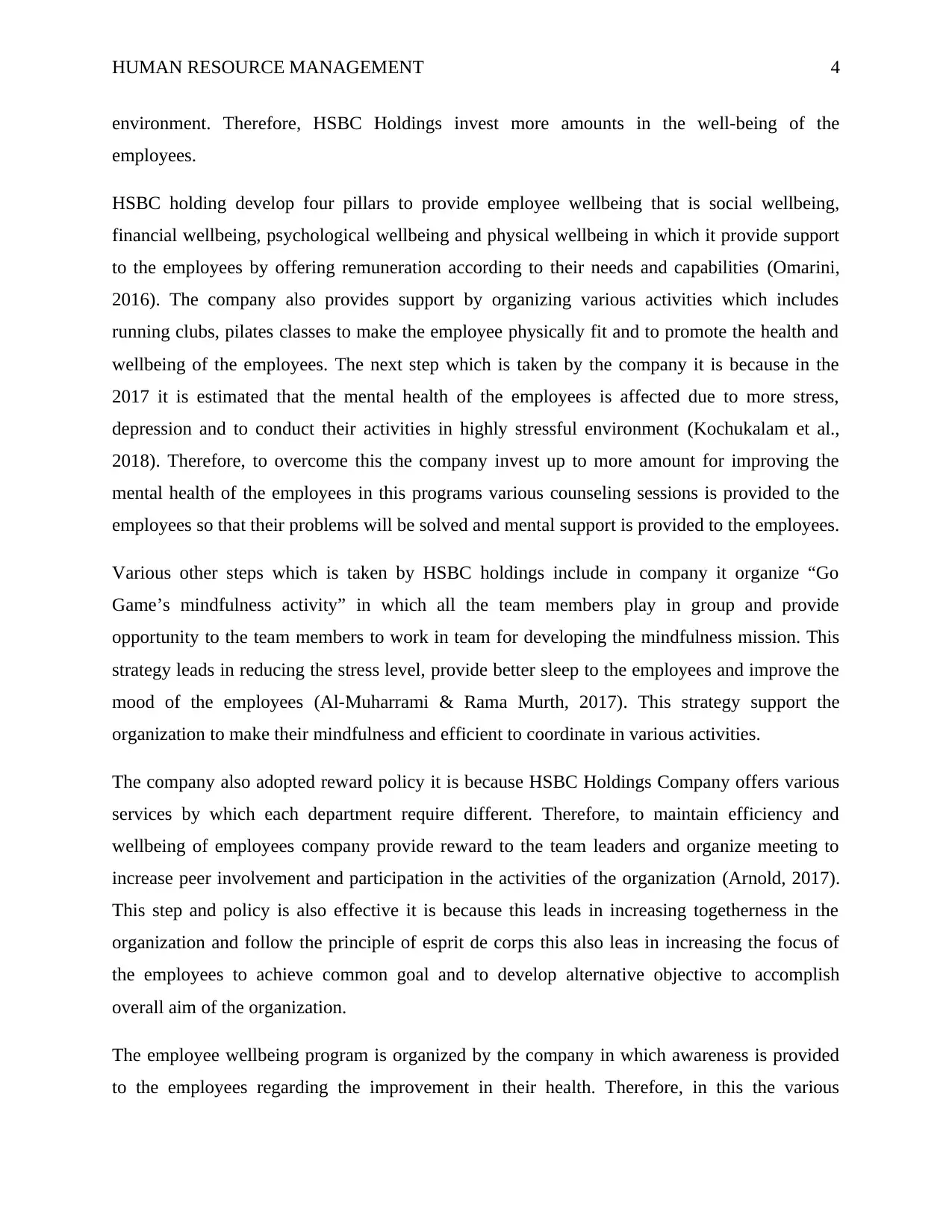
HUMAN RESOURCE MANAGEMENT 4
environment. Therefore, HSBC Holdings invest more amounts in the well-being of the
employees.
HSBC holding develop four pillars to provide employee wellbeing that is social wellbeing,
financial wellbeing, psychological wellbeing and physical wellbeing in which it provide support
to the employees by offering remuneration according to their needs and capabilities (Omarini,
2016). The company also provides support by organizing various activities which includes
running clubs, pilates classes to make the employee physically fit and to promote the health and
wellbeing of the employees. The next step which is taken by the company it is because in the
2017 it is estimated that the mental health of the employees is affected due to more stress,
depression and to conduct their activities in highly stressful environment (Kochukalam et al.,
2018). Therefore, to overcome this the company invest up to more amount for improving the
mental health of the employees in this programs various counseling sessions is provided to the
employees so that their problems will be solved and mental support is provided to the employees.
Various other steps which is taken by HSBC holdings include in company it organize “Go
Game’s mindfulness activity” in which all the team members play in group and provide
opportunity to the team members to work in team for developing the mindfulness mission. This
strategy leads in reducing the stress level, provide better sleep to the employees and improve the
mood of the employees (Al-Muharrami & Rama Murth, 2017). This strategy support the
organization to make their mindfulness and efficient to coordinate in various activities.
The company also adopted reward policy it is because HSBC Holdings Company offers various
services by which each department require different. Therefore, to maintain efficiency and
wellbeing of employees company provide reward to the team leaders and organize meeting to
increase peer involvement and participation in the activities of the organization (Arnold, 2017).
This step and policy is also effective it is because this leads in increasing togetherness in the
organization and follow the principle of esprit de corps this also leas in increasing the focus of
the employees to achieve common goal and to develop alternative objective to accomplish
overall aim of the organization.
The employee wellbeing program is organized by the company in which awareness is provided
to the employees regarding the improvement in their health. Therefore, in this the various
environment. Therefore, HSBC Holdings invest more amounts in the well-being of the
employees.
HSBC holding develop four pillars to provide employee wellbeing that is social wellbeing,
financial wellbeing, psychological wellbeing and physical wellbeing in which it provide support
to the employees by offering remuneration according to their needs and capabilities (Omarini,
2016). The company also provides support by organizing various activities which includes
running clubs, pilates classes to make the employee physically fit and to promote the health and
wellbeing of the employees. The next step which is taken by the company it is because in the
2017 it is estimated that the mental health of the employees is affected due to more stress,
depression and to conduct their activities in highly stressful environment (Kochukalam et al.,
2018). Therefore, to overcome this the company invest up to more amount for improving the
mental health of the employees in this programs various counseling sessions is provided to the
employees so that their problems will be solved and mental support is provided to the employees.
Various other steps which is taken by HSBC holdings include in company it organize “Go
Game’s mindfulness activity” in which all the team members play in group and provide
opportunity to the team members to work in team for developing the mindfulness mission. This
strategy leads in reducing the stress level, provide better sleep to the employees and improve the
mood of the employees (Al-Muharrami & Rama Murth, 2017). This strategy support the
organization to make their mindfulness and efficient to coordinate in various activities.
The company also adopted reward policy it is because HSBC Holdings Company offers various
services by which each department require different. Therefore, to maintain efficiency and
wellbeing of employees company provide reward to the team leaders and organize meeting to
increase peer involvement and participation in the activities of the organization (Arnold, 2017).
This step and policy is also effective it is because this leads in increasing togetherness in the
organization and follow the principle of esprit de corps this also leas in increasing the focus of
the employees to achieve common goal and to develop alternative objective to accomplish
overall aim of the organization.
The employee wellbeing program is organized by the company in which awareness is provided
to the employees regarding the improvement in their health. Therefore, in this the various
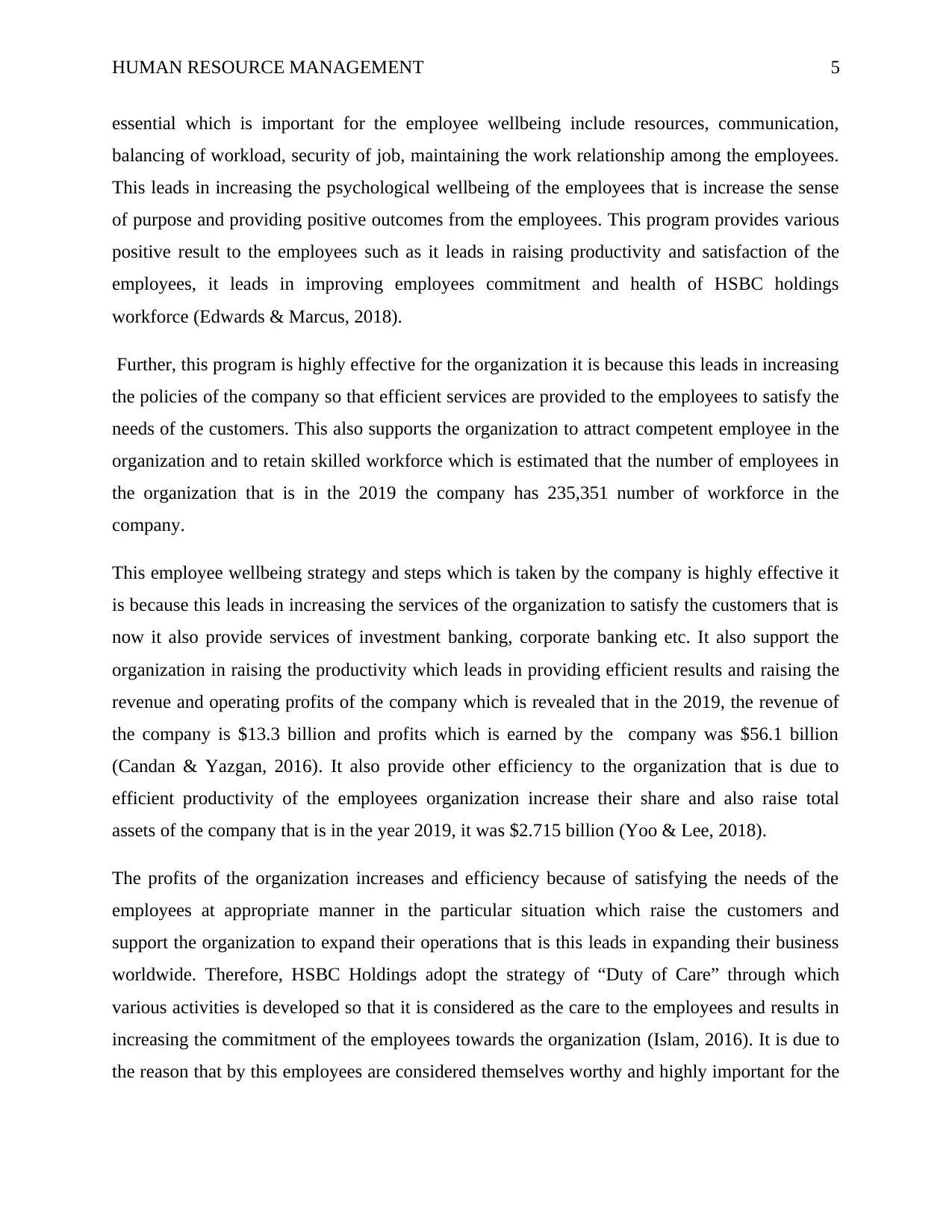
HUMAN RESOURCE MANAGEMENT 5
essential which is important for the employee wellbeing include resources, communication,
balancing of workload, security of job, maintaining the work relationship among the employees.
This leads in increasing the psychological wellbeing of the employees that is increase the sense
of purpose and providing positive outcomes from the employees. This program provides various
positive result to the employees such as it leads in raising productivity and satisfaction of the
employees, it leads in improving employees commitment and health of HSBC holdings
workforce (Edwards & Marcus, 2018).
Further, this program is highly effective for the organization it is because this leads in increasing
the policies of the company so that efficient services are provided to the employees to satisfy the
needs of the customers. This also supports the organization to attract competent employee in the
organization and to retain skilled workforce which is estimated that the number of employees in
the organization that is in the 2019 the company has 235,351 number of workforce in the
company.
This employee wellbeing strategy and steps which is taken by the company is highly effective it
is because this leads in increasing the services of the organization to satisfy the customers that is
now it also provide services of investment banking, corporate banking etc. It also support the
organization in raising the productivity which leads in providing efficient results and raising the
revenue and operating profits of the company which is revealed that in the 2019, the revenue of
the company is $13.3 billion and profits which is earned by the company was $56.1 billion
(Candan & Yazgan, 2016). It also provide other efficiency to the organization that is due to
efficient productivity of the employees organization increase their share and also raise total
assets of the company that is in the year 2019, it was $2.715 billion (Yoo & Lee, 2018).
The profits of the organization increases and efficiency because of satisfying the needs of the
employees at appropriate manner in the particular situation which raise the customers and
support the organization to expand their operations that is this leads in expanding their business
worldwide. Therefore, HSBC Holdings adopt the strategy of “Duty of Care” through which
various activities is developed so that it is considered as the care to the employees and results in
increasing the commitment of the employees towards the organization (Islam, 2016). It is due to
the reason that by this employees are considered themselves worthy and highly important for the
essential which is important for the employee wellbeing include resources, communication,
balancing of workload, security of job, maintaining the work relationship among the employees.
This leads in increasing the psychological wellbeing of the employees that is increase the sense
of purpose and providing positive outcomes from the employees. This program provides various
positive result to the employees such as it leads in raising productivity and satisfaction of the
employees, it leads in improving employees commitment and health of HSBC holdings
workforce (Edwards & Marcus, 2018).
Further, this program is highly effective for the organization it is because this leads in increasing
the policies of the company so that efficient services are provided to the employees to satisfy the
needs of the customers. This also supports the organization to attract competent employee in the
organization and to retain skilled workforce which is estimated that the number of employees in
the organization that is in the 2019 the company has 235,351 number of workforce in the
company.
This employee wellbeing strategy and steps which is taken by the company is highly effective it
is because this leads in increasing the services of the organization to satisfy the customers that is
now it also provide services of investment banking, corporate banking etc. It also support the
organization in raising the productivity which leads in providing efficient results and raising the
revenue and operating profits of the company which is revealed that in the 2019, the revenue of
the company is $13.3 billion and profits which is earned by the company was $56.1 billion
(Candan & Yazgan, 2016). It also provide other efficiency to the organization that is due to
efficient productivity of the employees organization increase their share and also raise total
assets of the company that is in the year 2019, it was $2.715 billion (Yoo & Lee, 2018).
The profits of the organization increases and efficiency because of satisfying the needs of the
employees at appropriate manner in the particular situation which raise the customers and
support the organization to expand their operations that is this leads in expanding their business
worldwide. Therefore, HSBC Holdings adopt the strategy of “Duty of Care” through which
various activities is developed so that it is considered as the care to the employees and results in
increasing the commitment of the employees towards the organization (Islam, 2016). It is due to
the reason that by this employees are considered themselves worthy and highly important for the
⊘ This is a preview!⊘
Do you want full access?
Subscribe today to unlock all pages.

Trusted by 1+ million students worldwide
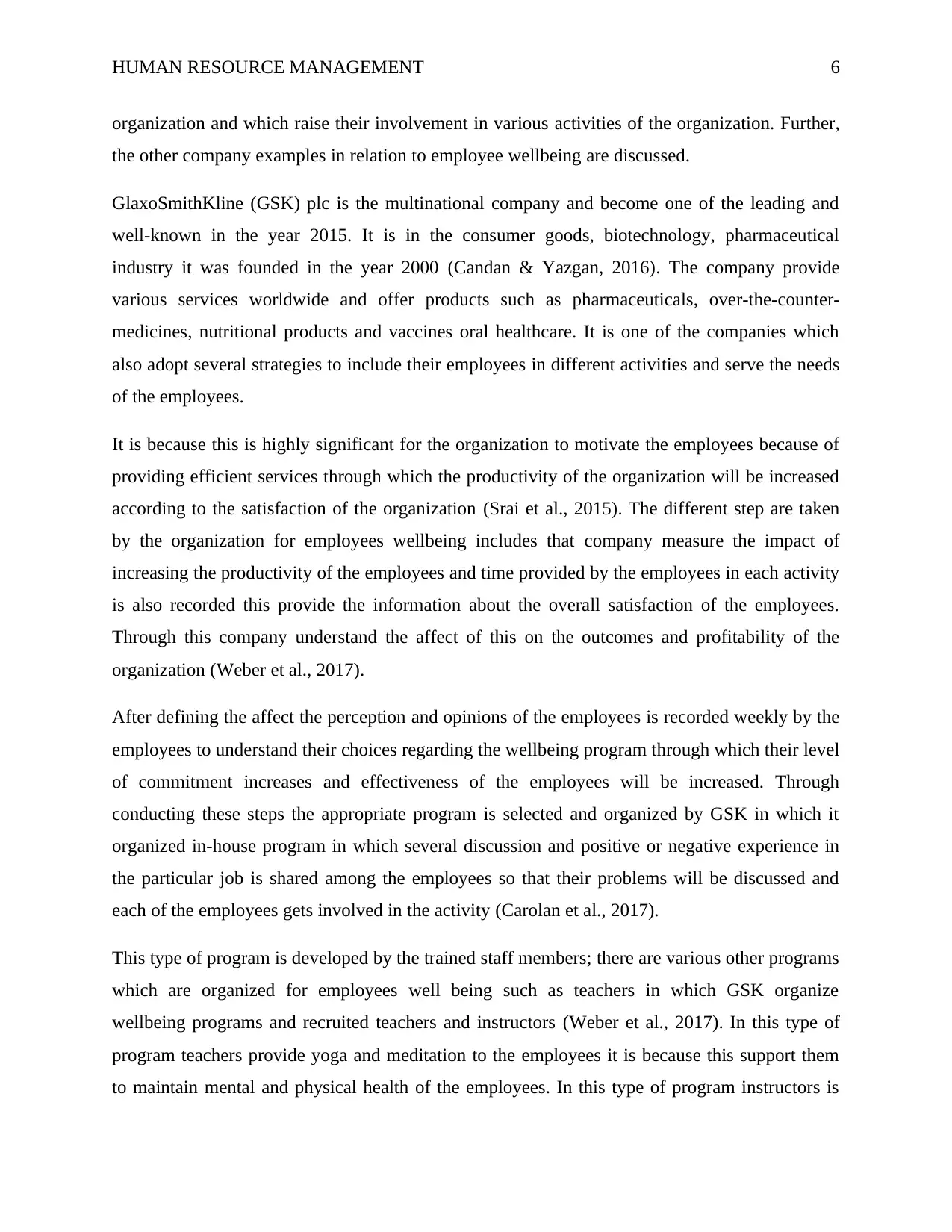
HUMAN RESOURCE MANAGEMENT 6
organization and which raise their involvement in various activities of the organization. Further,
the other company examples in relation to employee wellbeing are discussed.
GlaxoSmithKline (GSK) plc is the multinational company and become one of the leading and
well-known in the year 2015. It is in the consumer goods, biotechnology, pharmaceutical
industry it was founded in the year 2000 (Candan & Yazgan, 2016). The company provide
various services worldwide and offer products such as pharmaceuticals, over-the-counter-
medicines, nutritional products and vaccines oral healthcare. It is one of the companies which
also adopt several strategies to include their employees in different activities and serve the needs
of the employees.
It is because this is highly significant for the organization to motivate the employees because of
providing efficient services through which the productivity of the organization will be increased
according to the satisfaction of the organization (Srai et al., 2015). The different step are taken
by the organization for employees wellbeing includes that company measure the impact of
increasing the productivity of the employees and time provided by the employees in each activity
is also recorded this provide the information about the overall satisfaction of the employees.
Through this company understand the affect of this on the outcomes and profitability of the
organization (Weber et al., 2017).
After defining the affect the perception and opinions of the employees is recorded weekly by the
employees to understand their choices regarding the wellbeing program through which their level
of commitment increases and effectiveness of the employees will be increased. Through
conducting these steps the appropriate program is selected and organized by GSK in which it
organized in-house program in which several discussion and positive or negative experience in
the particular job is shared among the employees so that their problems will be discussed and
each of the employees gets involved in the activity (Carolan et al., 2017).
This type of program is developed by the trained staff members; there are various other programs
which are organized for employees well being such as teachers in which GSK organize
wellbeing programs and recruited teachers and instructors (Weber et al., 2017). In this type of
program teachers provide yoga and meditation to the employees it is because this support them
to maintain mental and physical health of the employees. In this type of program instructors is
organization and which raise their involvement in various activities of the organization. Further,
the other company examples in relation to employee wellbeing are discussed.
GlaxoSmithKline (GSK) plc is the multinational company and become one of the leading and
well-known in the year 2015. It is in the consumer goods, biotechnology, pharmaceutical
industry it was founded in the year 2000 (Candan & Yazgan, 2016). The company provide
various services worldwide and offer products such as pharmaceuticals, over-the-counter-
medicines, nutritional products and vaccines oral healthcare. It is one of the companies which
also adopt several strategies to include their employees in different activities and serve the needs
of the employees.
It is because this is highly significant for the organization to motivate the employees because of
providing efficient services through which the productivity of the organization will be increased
according to the satisfaction of the organization (Srai et al., 2015). The different step are taken
by the organization for employees wellbeing includes that company measure the impact of
increasing the productivity of the employees and time provided by the employees in each activity
is also recorded this provide the information about the overall satisfaction of the employees.
Through this company understand the affect of this on the outcomes and profitability of the
organization (Weber et al., 2017).
After defining the affect the perception and opinions of the employees is recorded weekly by the
employees to understand their choices regarding the wellbeing program through which their level
of commitment increases and effectiveness of the employees will be increased. Through
conducting these steps the appropriate program is selected and organized by GSK in which it
organized in-house program in which several discussion and positive or negative experience in
the particular job is shared among the employees so that their problems will be discussed and
each of the employees gets involved in the activity (Carolan et al., 2017).
This type of program is developed by the trained staff members; there are various other programs
which are organized for employees well being such as teachers in which GSK organize
wellbeing programs and recruited teachers and instructors (Weber et al., 2017). In this type of
program teachers provide yoga and meditation to the employees it is because this support them
to maintain mental and physical health of the employees. In this type of program instructors is
Paraphrase This Document
Need a fresh take? Get an instant paraphrase of this document with our AI Paraphraser
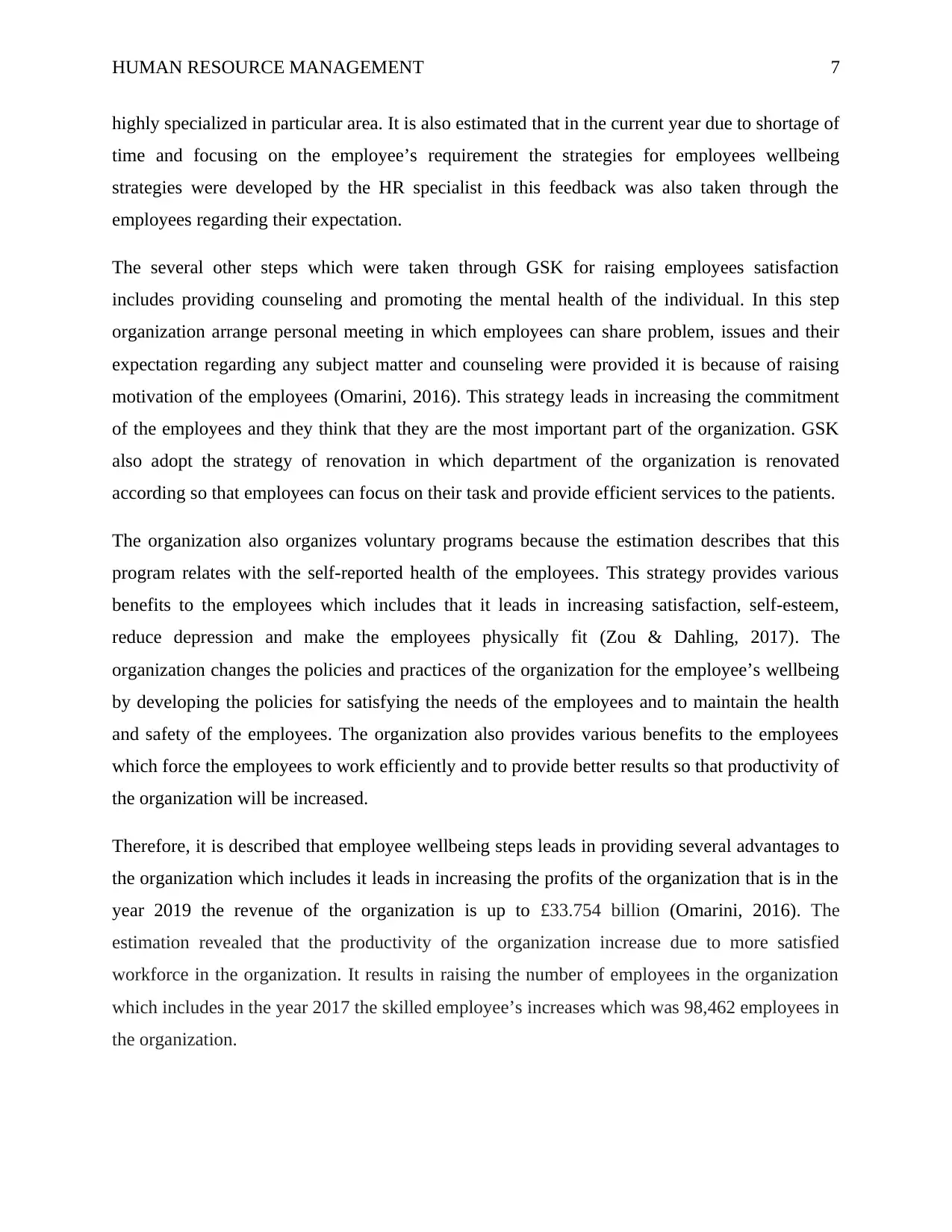
HUMAN RESOURCE MANAGEMENT 7
highly specialized in particular area. It is also estimated that in the current year due to shortage of
time and focusing on the employee’s requirement the strategies for employees wellbeing
strategies were developed by the HR specialist in this feedback was also taken through the
employees regarding their expectation.
The several other steps which were taken through GSK for raising employees satisfaction
includes providing counseling and promoting the mental health of the individual. In this step
organization arrange personal meeting in which employees can share problem, issues and their
expectation regarding any subject matter and counseling were provided it is because of raising
motivation of the employees (Omarini, 2016). This strategy leads in increasing the commitment
of the employees and they think that they are the most important part of the organization. GSK
also adopt the strategy of renovation in which department of the organization is renovated
according so that employees can focus on their task and provide efficient services to the patients.
The organization also organizes voluntary programs because the estimation describes that this
program relates with the self-reported health of the employees. This strategy provides various
benefits to the employees which includes that it leads in increasing satisfaction, self-esteem,
reduce depression and make the employees physically fit (Zou & Dahling, 2017). The
organization changes the policies and practices of the organization for the employee’s wellbeing
by developing the policies for satisfying the needs of the employees and to maintain the health
and safety of the employees. The organization also provides various benefits to the employees
which force the employees to work efficiently and to provide better results so that productivity of
the organization will be increased.
Therefore, it is described that employee wellbeing steps leads in providing several advantages to
the organization which includes it leads in increasing the profits of the organization that is in the
year 2019 the revenue of the organization is up to £33.754 billion (Omarini, 2016). The
estimation revealed that the productivity of the organization increase due to more satisfied
workforce in the organization. It results in raising the number of employees in the organization
which includes in the year 2017 the skilled employee’s increases which was 98,462 employees in
the organization.
highly specialized in particular area. It is also estimated that in the current year due to shortage of
time and focusing on the employee’s requirement the strategies for employees wellbeing
strategies were developed by the HR specialist in this feedback was also taken through the
employees regarding their expectation.
The several other steps which were taken through GSK for raising employees satisfaction
includes providing counseling and promoting the mental health of the individual. In this step
organization arrange personal meeting in which employees can share problem, issues and their
expectation regarding any subject matter and counseling were provided it is because of raising
motivation of the employees (Omarini, 2016). This strategy leads in increasing the commitment
of the employees and they think that they are the most important part of the organization. GSK
also adopt the strategy of renovation in which department of the organization is renovated
according so that employees can focus on their task and provide efficient services to the patients.
The organization also organizes voluntary programs because the estimation describes that this
program relates with the self-reported health of the employees. This strategy provides various
benefits to the employees which includes that it leads in increasing satisfaction, self-esteem,
reduce depression and make the employees physically fit (Zou & Dahling, 2017). The
organization changes the policies and practices of the organization for the employee’s wellbeing
by developing the policies for satisfying the needs of the employees and to maintain the health
and safety of the employees. The organization also provides various benefits to the employees
which force the employees to work efficiently and to provide better results so that productivity of
the organization will be increased.
Therefore, it is described that employee wellbeing steps leads in providing several advantages to
the organization which includes it leads in increasing the profits of the organization that is in the
year 2019 the revenue of the organization is up to £33.754 billion (Omarini, 2016). The
estimation revealed that the productivity of the organization increase due to more satisfied
workforce in the organization. It results in raising the number of employees in the organization
which includes in the year 2017 the skilled employee’s increases which was 98,462 employees in
the organization.
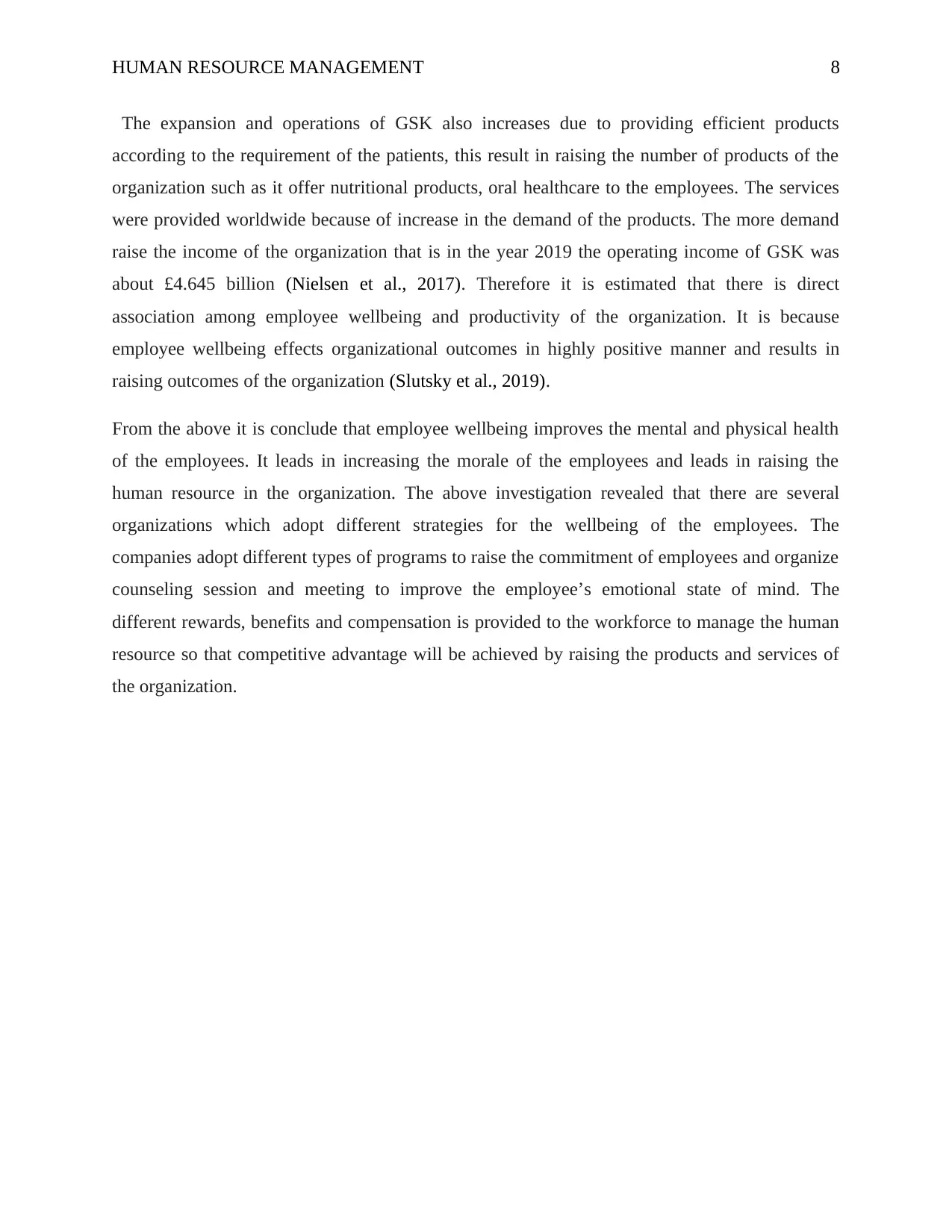
HUMAN RESOURCE MANAGEMENT 8
The expansion and operations of GSK also increases due to providing efficient products
according to the requirement of the patients, this result in raising the number of products of the
organization such as it offer nutritional products, oral healthcare to the employees. The services
were provided worldwide because of increase in the demand of the products. The more demand
raise the income of the organization that is in the year 2019 the operating income of GSK was
about £4.645 billion (Nielsen et al., 2017). Therefore it is estimated that there is direct
association among employee wellbeing and productivity of the organization. It is because
employee wellbeing effects organizational outcomes in highly positive manner and results in
raising outcomes of the organization (Slutsky et al., 2019).
From the above it is conclude that employee wellbeing improves the mental and physical health
of the employees. It leads in increasing the morale of the employees and leads in raising the
human resource in the organization. The above investigation revealed that there are several
organizations which adopt different strategies for the wellbeing of the employees. The
companies adopt different types of programs to raise the commitment of employees and organize
counseling session and meeting to improve the employee’s emotional state of mind. The
different rewards, benefits and compensation is provided to the workforce to manage the human
resource so that competitive advantage will be achieved by raising the products and services of
the organization.
The expansion and operations of GSK also increases due to providing efficient products
according to the requirement of the patients, this result in raising the number of products of the
organization such as it offer nutritional products, oral healthcare to the employees. The services
were provided worldwide because of increase in the demand of the products. The more demand
raise the income of the organization that is in the year 2019 the operating income of GSK was
about £4.645 billion (Nielsen et al., 2017). Therefore it is estimated that there is direct
association among employee wellbeing and productivity of the organization. It is because
employee wellbeing effects organizational outcomes in highly positive manner and results in
raising outcomes of the organization (Slutsky et al., 2019).
From the above it is conclude that employee wellbeing improves the mental and physical health
of the employees. It leads in increasing the morale of the employees and leads in raising the
human resource in the organization. The above investigation revealed that there are several
organizations which adopt different strategies for the wellbeing of the employees. The
companies adopt different types of programs to raise the commitment of employees and organize
counseling session and meeting to improve the employee’s emotional state of mind. The
different rewards, benefits and compensation is provided to the workforce to manage the human
resource so that competitive advantage will be achieved by raising the products and services of
the organization.
⊘ This is a preview!⊘
Do you want full access?
Subscribe today to unlock all pages.

Trusted by 1+ million students worldwide
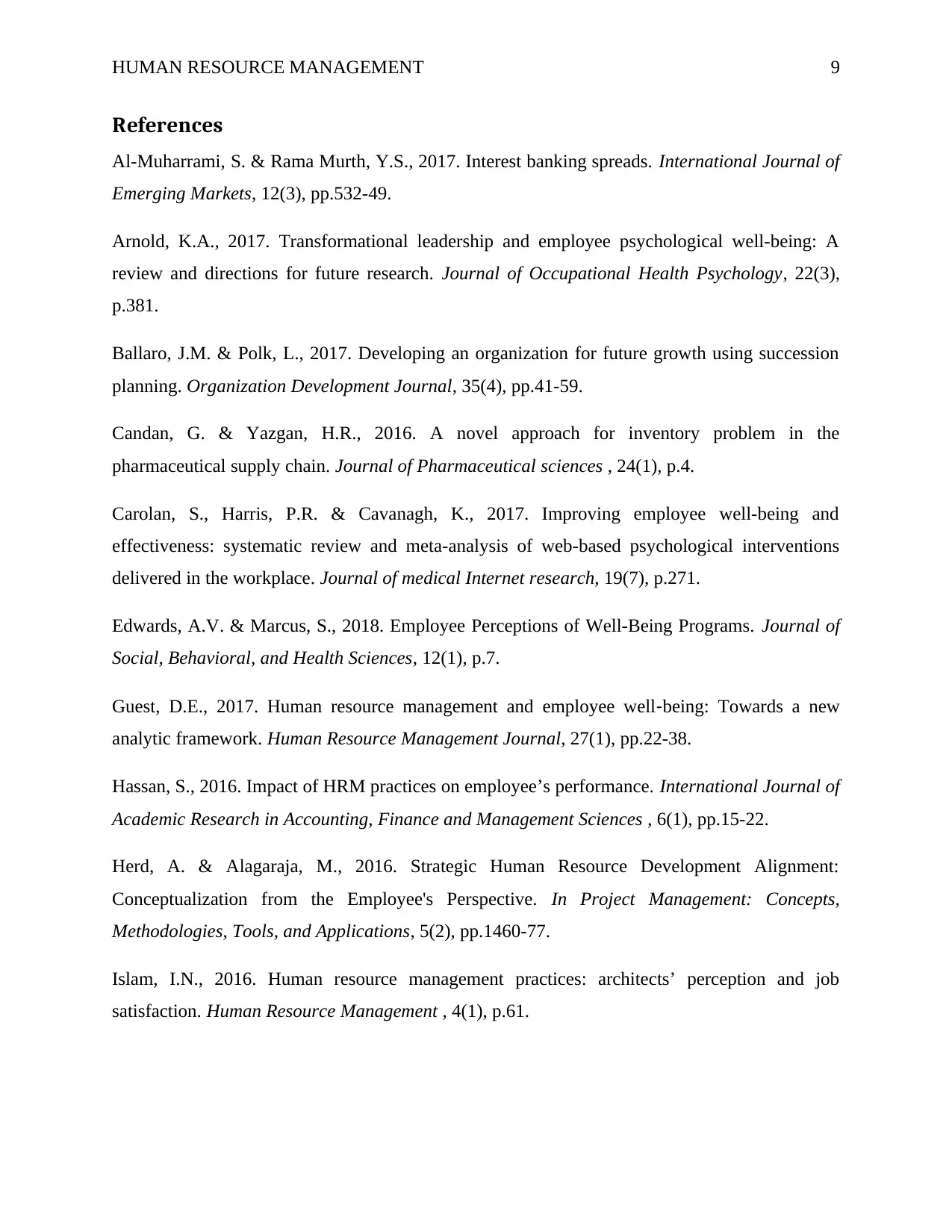
HUMAN RESOURCE MANAGEMENT 9
References
Al-Muharrami, S. & Rama Murth, Y.S., 2017. Interest banking spreads. International Journal of
Emerging Markets, 12(3), pp.532-49.
Arnold, K.A., 2017. Transformational leadership and employee psychological well-being: A
review and directions for future research. Journal of Occupational Health Psychology, 22(3),
p.381.
Ballaro, J.M. & Polk, L., 2017. Developing an organization for future growth using succession
planning. Organization Development Journal, 35(4), pp.41-59.
Candan, G. & Yazgan, H.R., 2016. A novel approach for inventory problem in the
pharmaceutical supply chain. Journal of Pharmaceutical sciences , 24(1), p.4.
Carolan, S., Harris, P.R. & Cavanagh, K., 2017. Improving employee well-being and
effectiveness: systematic review and meta-analysis of web-based psychological interventions
delivered in the workplace. Journal of medical Internet research, 19(7), p.271.
Edwards, A.V. & Marcus, S., 2018. Employee Perceptions of Well-Being Programs. Journal of
Social, Behavioral, and Health Sciences, 12(1), p.7.
Guest, D.E., 2017. Human resource management and employee well‐being: Towards a new
analytic framework. Human Resource Management Journal, 27(1), pp.22-38.
Hassan, S., 2016. Impact of HRM practices on employee’s performance. International Journal of
Academic Research in Accounting, Finance and Management Sciences , 6(1), pp.15-22.
Herd, A. & Alagaraja, M., 2016. Strategic Human Resource Development Alignment:
Conceptualization from the Employee's Perspective. In Project Management: Concepts,
Methodologies, Tools, and Applications, 5(2), pp.1460-77.
Islam, I.N., 2016. Human resource management practices: architects’ perception and job
satisfaction. Human Resource Management , 4(1), p.61.
References
Al-Muharrami, S. & Rama Murth, Y.S., 2017. Interest banking spreads. International Journal of
Emerging Markets, 12(3), pp.532-49.
Arnold, K.A., 2017. Transformational leadership and employee psychological well-being: A
review and directions for future research. Journal of Occupational Health Psychology, 22(3),
p.381.
Ballaro, J.M. & Polk, L., 2017. Developing an organization for future growth using succession
planning. Organization Development Journal, 35(4), pp.41-59.
Candan, G. & Yazgan, H.R., 2016. A novel approach for inventory problem in the
pharmaceutical supply chain. Journal of Pharmaceutical sciences , 24(1), p.4.
Carolan, S., Harris, P.R. & Cavanagh, K., 2017. Improving employee well-being and
effectiveness: systematic review and meta-analysis of web-based psychological interventions
delivered in the workplace. Journal of medical Internet research, 19(7), p.271.
Edwards, A.V. & Marcus, S., 2018. Employee Perceptions of Well-Being Programs. Journal of
Social, Behavioral, and Health Sciences, 12(1), p.7.
Guest, D.E., 2017. Human resource management and employee well‐being: Towards a new
analytic framework. Human Resource Management Journal, 27(1), pp.22-38.
Hassan, S., 2016. Impact of HRM practices on employee’s performance. International Journal of
Academic Research in Accounting, Finance and Management Sciences , 6(1), pp.15-22.
Herd, A. & Alagaraja, M., 2016. Strategic Human Resource Development Alignment:
Conceptualization from the Employee's Perspective. In Project Management: Concepts,
Methodologies, Tools, and Applications, 5(2), pp.1460-77.
Islam, I.N., 2016. Human resource management practices: architects’ perception and job
satisfaction. Human Resource Management , 4(1), p.61.
Paraphrase This Document
Need a fresh take? Get an instant paraphrase of this document with our AI Paraphraser
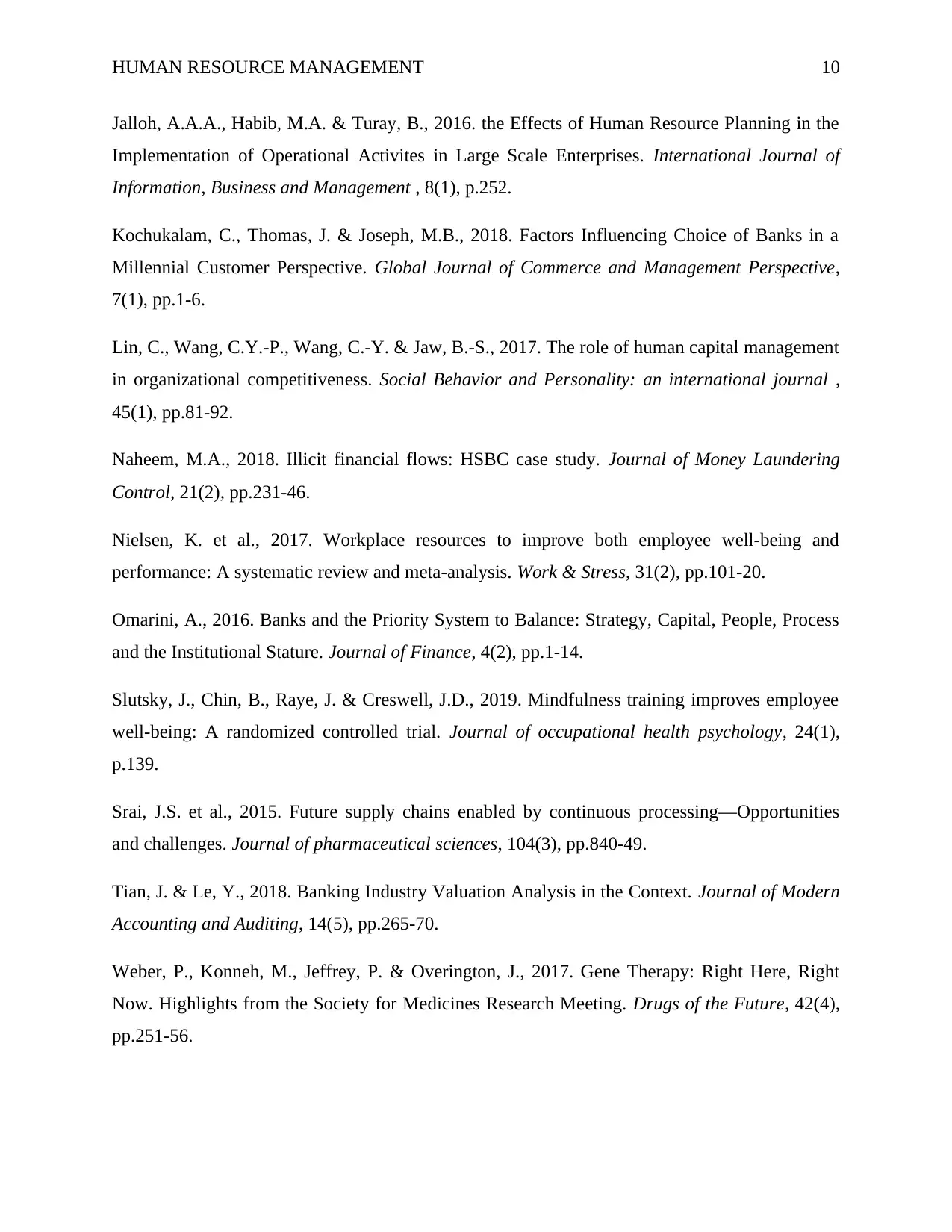
HUMAN RESOURCE MANAGEMENT 10
Jalloh, A.A.A., Habib, M.A. & Turay, B., 2016. the Effects of Human Resource Planning in the
Implementation of Operational Activites in Large Scale Enterprises. International Journal of
Information, Business and Management , 8(1), p.252.
Kochukalam, C., Thomas, J. & Joseph, M.B., 2018. Factors Influencing Choice of Banks in a
Millennial Customer Perspective. Global Journal of Commerce and Management Perspective,
7(1), pp.1-6.
Lin, C., Wang, C.Y.-P., Wang, C.-Y. & Jaw, B.-S., 2017. The role of human capital management
in organizational competitiveness. Social Behavior and Personality: an international journal ,
45(1), pp.81-92.
Naheem, M.A., 2018. Illicit financial flows: HSBC case study. Journal of Money Laundering
Control, 21(2), pp.231-46.
Nielsen, K. et al., 2017. Workplace resources to improve both employee well-being and
performance: A systematic review and meta-analysis. Work & Stress, 31(2), pp.101-20.
Omarini, A., 2016. Banks and the Priority System to Balance: Strategy, Capital, People, Process
and the Institutional Stature. Journal of Finance, 4(2), pp.1-14.
Slutsky, J., Chin, B., Raye, J. & Creswell, J.D., 2019. Mindfulness training improves employee
well-being: A randomized controlled trial. Journal of occupational health psychology, 24(1),
p.139.
Srai, J.S. et al., 2015. Future supply chains enabled by continuous processing—Opportunities
and challenges. Journal of pharmaceutical sciences, 104(3), pp.840-49.
Tian, J. & Le, Y., 2018. Banking Industry Valuation Analysis in the Context. Journal of Modern
Accounting and Auditing, 14(5), pp.265-70.
Weber, P., Konneh, M., Jeffrey, P. & Overington, J., 2017. Gene Therapy: Right Here, Right
Now. Highlights from the Society for Medicines Research Meeting. Drugs of the Future, 42(4),
pp.251-56.
Jalloh, A.A.A., Habib, M.A. & Turay, B., 2016. the Effects of Human Resource Planning in the
Implementation of Operational Activites in Large Scale Enterprises. International Journal of
Information, Business and Management , 8(1), p.252.
Kochukalam, C., Thomas, J. & Joseph, M.B., 2018. Factors Influencing Choice of Banks in a
Millennial Customer Perspective. Global Journal of Commerce and Management Perspective,
7(1), pp.1-6.
Lin, C., Wang, C.Y.-P., Wang, C.-Y. & Jaw, B.-S., 2017. The role of human capital management
in organizational competitiveness. Social Behavior and Personality: an international journal ,
45(1), pp.81-92.
Naheem, M.A., 2018. Illicit financial flows: HSBC case study. Journal of Money Laundering
Control, 21(2), pp.231-46.
Nielsen, K. et al., 2017. Workplace resources to improve both employee well-being and
performance: A systematic review and meta-analysis. Work & Stress, 31(2), pp.101-20.
Omarini, A., 2016. Banks and the Priority System to Balance: Strategy, Capital, People, Process
and the Institutional Stature. Journal of Finance, 4(2), pp.1-14.
Slutsky, J., Chin, B., Raye, J. & Creswell, J.D., 2019. Mindfulness training improves employee
well-being: A randomized controlled trial. Journal of occupational health psychology, 24(1),
p.139.
Srai, J.S. et al., 2015. Future supply chains enabled by continuous processing—Opportunities
and challenges. Journal of pharmaceutical sciences, 104(3), pp.840-49.
Tian, J. & Le, Y., 2018. Banking Industry Valuation Analysis in the Context. Journal of Modern
Accounting and Auditing, 14(5), pp.265-70.
Weber, P., Konneh, M., Jeffrey, P. & Overington, J., 2017. Gene Therapy: Right Here, Right
Now. Highlights from the Society for Medicines Research Meeting. Drugs of the Future, 42(4),
pp.251-56.
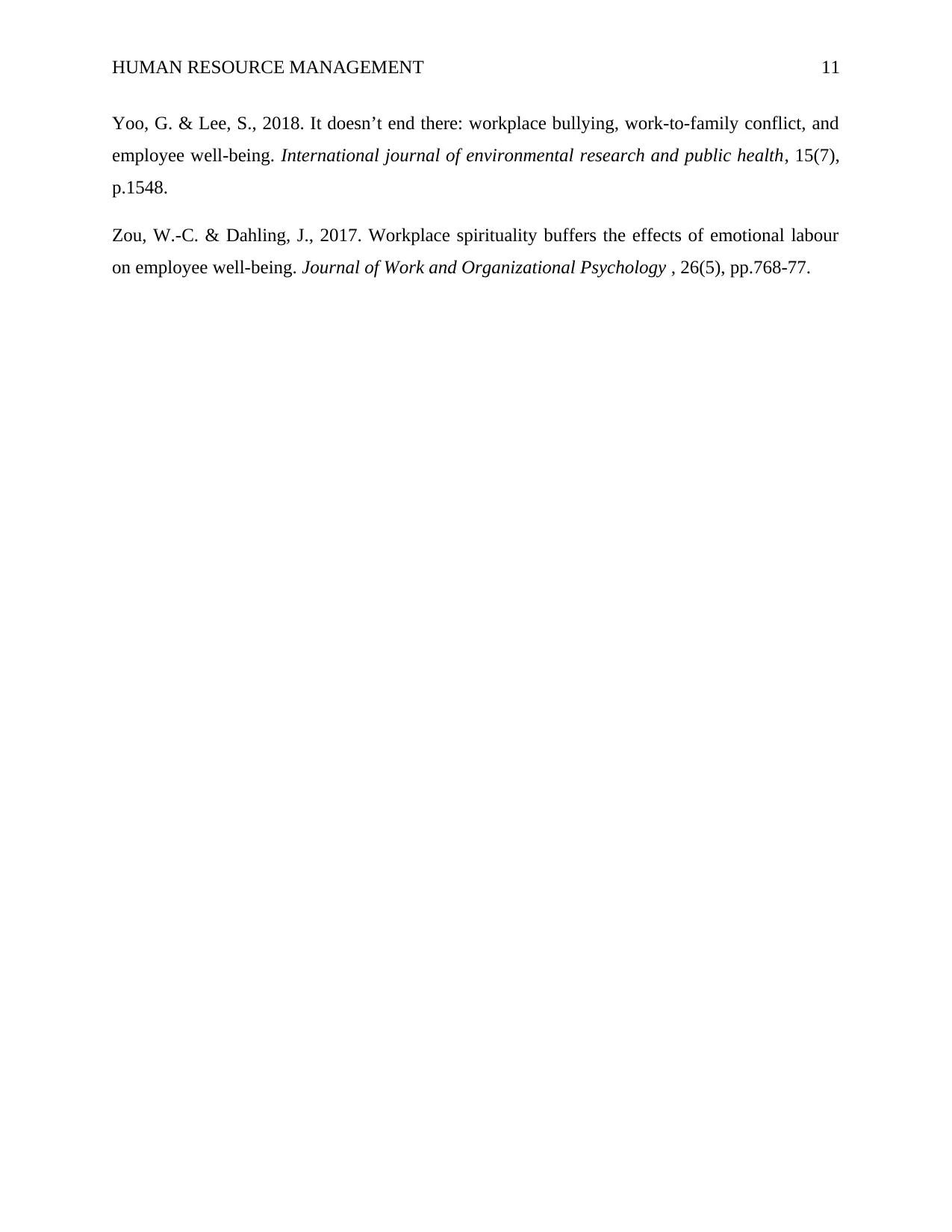
HUMAN RESOURCE MANAGEMENT 11
Yoo, G. & Lee, S., 2018. It doesn’t end there: workplace bullying, work-to-family conflict, and
employee well-being. International journal of environmental research and public health, 15(7),
p.1548.
Zou, W.-C. & Dahling, J., 2017. Workplace spirituality buffers the effects of emotional labour
on employee well-being. Journal of Work and Organizational Psychology , 26(5), pp.768-77.
Yoo, G. & Lee, S., 2018. It doesn’t end there: workplace bullying, work-to-family conflict, and
employee well-being. International journal of environmental research and public health, 15(7),
p.1548.
Zou, W.-C. & Dahling, J., 2017. Workplace spirituality buffers the effects of emotional labour
on employee well-being. Journal of Work and Organizational Psychology , 26(5), pp.768-77.
⊘ This is a preview!⊘
Do you want full access?
Subscribe today to unlock all pages.

Trusted by 1+ million students worldwide
1 out of 12
Related Documents
Your All-in-One AI-Powered Toolkit for Academic Success.
+13062052269
info@desklib.com
Available 24*7 on WhatsApp / Email
![[object Object]](/_next/static/media/star-bottom.7253800d.svg)
Unlock your academic potential
Copyright © 2020–2025 A2Z Services. All Rights Reserved. Developed and managed by ZUCOL.





